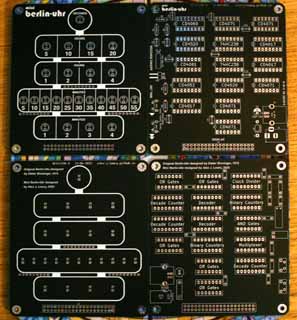

Mini Berlin-Uhr
Introduction
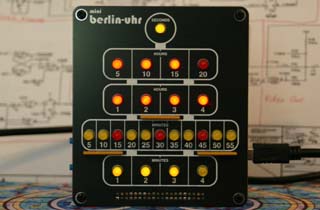 In
the city of Berlin, many unusual timepieces can be found. Among them are
the Clock of Flowing Time (West Berlin, 1982), the World Clock
(East
Berlin, 1969), and the Set Theory Clock (also known as the Berlin
Clock, or Berlin-Uhr in German), designed by Dieter Binninger in 1975.
In
the city of Berlin, many unusual timepieces can be found. Among them are
the Clock of Flowing Time (West Berlin, 1982), the World Clock
(East
Berlin, 1969), and the Set Theory Clock (also known as the Berlin
Clock, or Berlin-Uhr in German), designed by Dieter Binninger in 1975.
In the 70's and 80's, miniature desktop versions of the clock were sold
by Binninger's company. Due to being out of production for decades, these
original replicas have unfortunately become rare collectibles, selling
for over $100 online.
Binninger even planned to make a wristwatch-sized version of the clock,
but the price of creating the custom miniaturized components that would've
been required in the 1970's made this impossible.
It should be possible to obtain the components necessary to construct
this replica for approximately $40-50. If you plan on buying components
in bulk and selling the clock as a kit (I don't impose any restrictions
on anyone who wants to do this - you are free to sell any of the circuits
I've designed!), the price per unit could probably be reduced to around
$25-30.
The Berlin-Uhr is believed to be the key to solving Kryptos, a codebreaking
puzzle that has baffled the CIA and NSA since 1990!
Technical Description
This clock is based on 40xx and 74HCxx CMOS logic ICs. This results in
a wide tolerance for the supply voltage; it will run on any DC supply between
3 to 6 volts. The clock can be powered by a DC barrel jack or a USB-B connector.
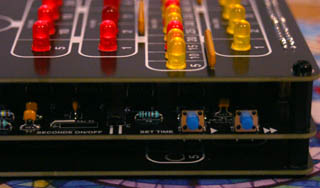 The
logic and display PCBs connect to each other via a 40-pin header. A pin
socket is mounted on the underside of the display, and a pin header (which
should be decently tall) is mounted on the top of the logic PCB. A spare
display PCB can be used to cover up the back of the logic board.
The
logic and display PCBs connect to each other via a 40-pin header. A pin
socket is mounted on the underside of the display, and a pin header (which
should be decently tall) is mounted on the top of the logic PCB. A spare
display PCB can be used to cover up the back of the logic board.
The PCB layers that make up the clock can be mounted on each other using
M3 screws and standoffs.
A simple circuit is used for setting the time, similar to many digital
clocks of the 70's and 80's. Holding down either of the buttons on the
side of the clock reduces the number of clock divider stages before the
1-second signal, causing the clock to run faster. The "fast set" button
is used to roughly set the time, and the "slow set" button is used to slowly
count up to the correct time.
The limitation of this circuit is that the time can't be adjusted backwards,
so you'll have to make sure not to overstep the correct time.
The clock displays 24-hour time. From top to bottom, the light zones
are read as follows:
-
Seconds: Alternates between "off" for even seconds (0, 2, 4...)
and "on" for odd seconds (1, 3, 5...). A jumper on the side of the clock
allows this light to be disabled if you find the blinking to be distracting.
-
Hours x5: Each light represents 5 hours.
-
Hours x1: Each light represents 1 hour. The value of this zone is
added to the zone above.
-
Minutes x5: Each light represents 5 minutes.
-
Minutes x1: Each light represents 1 minute. The value of this zone
is added to the zone above.
After 23:59, the clock resets to 00:00.
The display PCB has numbers printed under each LED so that the clock
is easier to read.
The brightness of the LEDs is determined by the three resistor packs on the
display PCB. I recommend 2KΩ packs, but if you plan on placing the clock in
a well-lit environment, you may want to use 1KΩ packs instead. Resistor packs
lower than 1KΩ are not recommended, as the LEDs are driven directly by CMOS
logic outputs.
Downloads
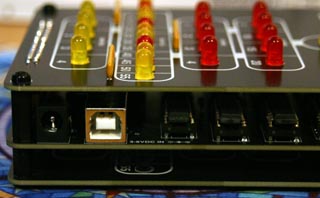
 Bill of Materials - Logic (Interactive)
Bill of Materials - Logic (Interactive)
HTML document, 373 KB - A list of all the
components you'll need to build the logic PCB.
 Bill of Materials - Display (Interactive)
Bill of Materials - Display (Interactive)
HTML document, 302 KB - A list of all the
components you'll need to build the display PCB.
 Logic Schematic
Logic Schematic
PDF document, 507 KB
 Display Schematic
Display Schematic
PDF document, 173 KB
 Logic PCB Gerbers
Logic PCB Gerbers
ZIP archive, 394 KB
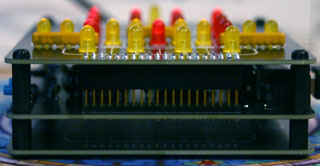
 Display PCB Gerbers
Display PCB Gerbers
ZIP archive, 175 KB
 Logic PCB KiCad Files
Logic PCB KiCad Files
ZIP archive, 922 KB - Useful if you want
to make modifications to the logic PCB. Made with KiCad 9.
 Display PCB KiCad Files
Display PCB KiCad Files
ZIP archive, 575 KB - Useful if you want
to make modifications to the display PCB. Made with KiCad 9.
 Custom Fonts
Custom Fonts
ZIP archive, 141 KB - Custom fonts used for
the KiCad files. Only needed if you want to modify these files.
Thanks to:
Dieter Binninger for designing the original Berlin-Uhr.
John
Schuch for designing the 4060
timebase circuit used in this clock.
Last updated on Aug 11, 2025.
This page was first uploaded on Aug 10, 2025.
 The
logic and display PCBs connect to each other via a 40-pin header. A pin
socket is mounted on the underside of the display, and a pin header (which
should be decently tall) is mounted on the top of the logic PCB. A spare
display PCB can be used to cover up the back of the logic board.
The
logic and display PCBs connect to each other via a 40-pin header. A pin
socket is mounted on the underside of the display, and a pin header (which
should be decently tall) is mounted on the top of the logic PCB. A spare
display PCB can be used to cover up the back of the logic board.


 In
the city of Berlin, many unusual timepieces can be found. Among them are
the Clock of Flowing Time (West Berlin, 1982), the World Clock
(East
Berlin, 1969), and the Set Theory Clock (also known as the Berlin
Clock, or Berlin-Uhr in German), designed by Dieter Binninger in 1975.
In
the city of Berlin, many unusual timepieces can be found. Among them are
the Clock of Flowing Time (West Berlin, 1982), the World Clock
(East
Berlin, 1969), and the Set Theory Clock (also known as the Berlin
Clock, or Berlin-Uhr in German), designed by Dieter Binninger in 1975.


